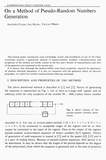Article
Full entry |
 PDF
(0.6 MB)
Feedback
PDF
(0.6 MB)
Feedback
 PDF
(0.6 MB)
Feedback
PDF
(0.6 MB)
Feedback
References:
[1] S. W. Golomb: Sequences with Randomness Properties. Glenn L. Martin Co., Baltimore, Md, June 14, 1955.
[2] D. C. J. Poortvliet: The Measurement of System Impulse Response by Cross-correlation with Binary Signals. Technical University, Delft 1962.
[3] W. W. Peterson: Error-Correcting Codes. M.I.T. Press, 1961 - Russian translation, Moskva 1964. MR 0178999 | Zbl 0105.32802
[4] R. C. Tausworthe: Random Numbers Generated by Linear Recurrence Modulo Two. Math. of Computation 19 (Apr. 1965), 90, 201-209. MR 0184406
[5] R. L. T. Hampton: A Hybrid Analog-Digital Pseudo-Random Noise Generator. Analog Hybrid Computer Laboratory, The University of Arizona, Tuscon, Arizona.
[6] Marolf R. A.: $200$ Mbit/s Pseudo-Random Sequence Generators for very Wide Band Secure Communication Systems. Proc. Nat. Electron, Conf. Chicago III, (1963), 183- 187.
[7] Hampton L., Korn G. A., Mittchell B.: Hybrid Analog-Digital Random Noise Generation. IEEE Trans. on Electronic Comp. (1963), 412-413.
[8] C. Kramer: A Low Frequency Pseudo-Random Noise Generator. Electr. Eng. (1965), 465-467.
[9] Watson E. J.: Primitive Polynomials (mod 2). Mathematics of Computation XV (1962), 368-369. MR 0148256 | Zbl 0101.25603
[10] J. Havel: Měnič pravděpodobnosti (Probability Transformer). Slaboproudý obzor 24 (1963), 2, 83-88.
[11] J. Havel: Elektronický generátor náhodných posloupností (An Electronic Generator of Random Sequences). Slaboproudý obzor 20 (1959), 12, 735-740. MR 0134431
[12] Huffman D. A.: The Synthesis of Linear Sequential Coding Networks. Proc. 3rd London Symp. on Inf. Theory. Zbl 0152.35702

